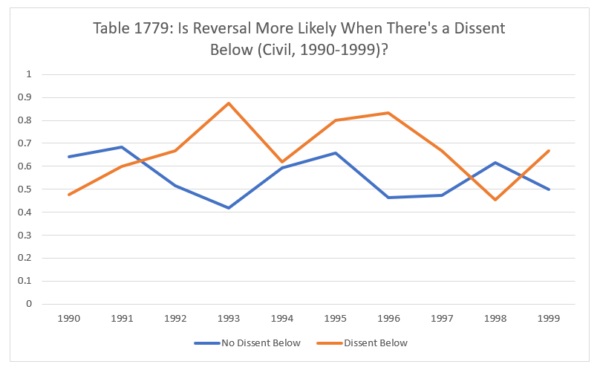- with readers working within the Retail & Leisure industries
For the next three weeks, we'll be reviewing data closely related to our just-concluded look at dissents below and at the Supreme Court. This time, we're asking a related question – is the Supreme Court more likely to reverse when there's a dissent below? Or to put it another way – is there reason to believe that the Supreme Court hears cases with a dissent below because it agrees with the dissenter? We begin with civil cases for the years 1990 through 1999, comparing two data points: yearly percentage of cases with a dissent below which resulted in a reversal, and yearly percentage of cases decided unanimously below which resulted in a reversal.
For these years, although the effect isn't dramatic, it's definitely there – reversal is more likely if there's a dissent below. In seven of the ten years from 1990 to 1999, the percentage of cases with a dissent below which resulted in reversal outpaced the no-dissent reversals. Overall for the period, cases with a dissent at the Appellate Court had a reversal at the Supreme Court in 64.83% of cases, while cases with no dissent below had a reversal in 56.24%. The data was especially lopsided in 1992 (66.67% dissent below, reversal above, 51.39% no dissent below, reversal above); 1993 (87.5% to 41.94%), 1995 (80% to 65.85%); 1996 (83.33% to 46.51%); 1997 (66.67% to 47.37%), and 1999 (66.67% to 50%).

Join us back here next time as we review the data for criminal cases in the same period.
Image courtesy of Flickr by Gary Todd (no changes).
The content of this article is intended to provide a general guide to the subject matter. Specialist advice should be sought about your specific circumstances.
[View Source]
